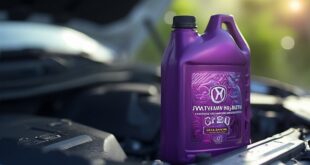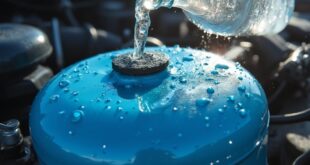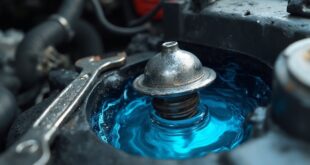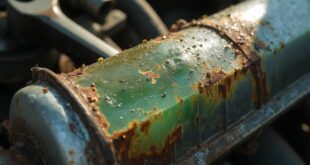A serpentine belt squeals primarily due to wear, tension issues, or faulty components. If the belt's rubber is deteriorating, it may produce noise. Loose belts from bad tensioners can create squealing sounds, while misaligned or defective pulleys may cause slipping. Coolant exposure can also damage the belt, leading to a persistent squeal. It's important to address these issues promptly to avoid further complications. There's plenty more to uncover about maintaining your serpentine belt effectively.
Understanding Serpentine Belts
Serpentine belts are crucial components in modern vehicles, connecting various accessories like the alternator, power steering pump, and air conditioning compressor to the engine.
These belts are typically made from durable synthetic rubber, designed to withstand high levels of tension and friction. They play a critical role in ensuring your vehicle runs smoothly, powering essential systems.
Since they're subject to wear and tear, it's important to monitor their condition regularly. A damaged belt can lead to decreased performance and potential engine problems.
Understanding their function helps you recognize when it's time for maintenance or replacement, keeping your vehicle in top shape.
Common Causes of Serpentine Belt Noise
Understanding the function of serpentine belts helps you identify when something's not right. If you hear a squealing noise, it could stem from various issues.
Common causes include:
- Worn-out belt: Rubber deteriorates over time, leading to noise.
- Bad tensioner: A loose belt from a failing tensioner creates additional sound.
- Faulty pulley: Resistance or wear in pulleys can cause slipping and noise.
- Coolant exposure: Spills can lead to permanent damage, resulting in squealing.
Addressing these issues promptly can prevent further damage and keep your vehicle running smoothly.
Regular inspections are essential for maintaining your serpentine belt's health.
Worn Out Belt: Signs and Symptoms
A worn-out belt can signal trouble for your vehicle, often manifesting as squealing or chirping noises.
As the belt deteriorates, you might notice visible cracks or fraying along its surface. If you hear these sounds when starting your engine or accelerating, it's a strong indication that the belt's lifespan is nearing its end.
Additionally, you could experience issues with power steering or air conditioning as the belt struggles to function properly.
Ignoring these signs can lead to complete belt failure, increasing repair costs and risking damage to other engine components, so timely inspection and replacement are essential.
The Role of the Tensioner in Belt Functionality
Without the proper tension, the serpentine belt can't perform effectively, which is where the tensioner comes into play. The tensioner maintains the correct tightness of the belt, ensuring smooth operation of various engine components.
If the tensioner's faulty, it can lead to a loose belt, causing that annoying squealing noise.
- The tensioner's spring-loaded design provides constant pressure.
- A failing tensioner can accelerate belt wear.
- Regular inspection helps prevent tensioner-related issues.
- Replacing a faulty tensioner can restore belt functionality and reduce noise.
Keeping an eye on your tensioner is essential for a well-functioning serpentine belt system.
Impact of Faulty Pulleys on Serpentine Belt Noise
When pulleys malfunction, they can considerably contribute to serpentine belt noise, leading to frustrating and potentially costly issues.
A faulty or stuck pulley can cause the belt to slip, which results in annoying squeaking or chirping sounds. This noise often worsens during acceleration, indicating that the belt isn't spinning correctly.
If you ignore these symptoms, the problem can escalate, damaging both the belt and the affected components.
Regular inspections and prompt repairs are essential to keep your serpentine belt functioning smoothly and to prevent further complications that could lead to expensive repairs down the road.
Stay proactive to avoid unnecessary costs.
Consequences of Misaligned Idler Pulleys
Faulty pulleys can lead to a cascade of problems, and misaligned idler pulleys are no exception. When the idler pulley isn't aligned properly, it can cause your serpentine belt to slip, resulting in increased wear and tear.
You might notice a squealing noise, but the consequences go beyond sound:
- Reduced efficiency of engine components
- Increased risk of belt failure
- Potential damage to other pulleys and accessories
- Higher repair costs over time
Addressing misalignment early guarantees your vehicle runs smoothly and prevents further complications, so don't ignore those warning signs!
The Effect of Coolant Exposure on Serpentine Belts
Coolant exposure can greatly impact the performance and lifespan of serpentine belts, so it's crucial to address any leaks immediately.
When coolant seeps onto the belt, it can cause slippage, leading to squealing noises and increased wear. Even small spills can damage the rubber, making it brittle and prone to cracking.
If you notice coolant near the belt, inspect for leaks and clean the area thoroughly. Ignoring this issue may result in a belt that needs replacing sooner than expected, ultimately costing you more in repairs.
Regular maintenance can help prevent such problems and extend your belt's life.
Diagnosing Squealing Noises: Steps to Take
Addressing coolant leaks is just one aspect of maintaining your serpentine belt.
To diagnose that annoying squealing noise, follow these steps:
- Listen carefully to when the noise occurs; note if it changes with engine temperature.
- Examine the belt for visible cracks or wear; replace it if damaged.
- Look for coolant spills around the belt; it can cause permanent damage.
- Check tension on the pulleys; a loose belt may need tightening.
Repairing and Replacing a Noisy Serpentine Belt
When your serpentine belt starts to squeal, tackling the issue promptly can save you from more extensive repairs down the line.
Start by getting a diagram of the belt routing for reference. Release the tensioner and carefully remove the old belt. Inspect the pulleys for alignment and cleanliness; replace any faulty ones.
Install the new belt according to the diagram, confirming proper routing. Finally, release the tensioner to secure it in place.
Double-check the alignment and tightness. If you're unsure, don't hesitate to consult a mechanic to confirm everything's done correctly and prevent future issues.
Preventative Measures for Serpentine Belt Maintenance
Regular maintenance of your serpentine belt can prevent costly repairs and extend its lifespan. By staying proactive, you'll save time and money in the long run.
- Inspect the belt for signs of wear, like cracks or fraying.
- Check the tensioner and pulleys for proper alignment and smooth operation.
- Keep the belt clean and free from coolant or debris that could cause slippage.
- Replace the belt every 50,000 to 100,000 miles, or sooner if you notice any issues.
These simple steps guarantee your serpentine belt functions efficiently, reducing the risk of annoying squealing noises.
Frequently Asked Questions
How Often Should I Inspect My Serpentine Belt?
You should inspect your serpentine belt every 30,000 miles or during regular maintenance checks. If you notice any unusual noises or wear signs, check it sooner to prevent potential failures and costly repairs.
Can a Squealing Serpentine Belt Affect Fuel Efficiency?
A squealing serpentine belt can negatively impact fuel efficiency. When the belt slips, it forces the engine to work harder, consuming more fuel. You should address the issue promptly to maintain peak performance and fuel economy.
What Tools Are Needed for Serpentine Belt Replacement?
To replace a serpentine belt, you'll need a socket set, a wrench, a ratchet, a belt tensioner tool, and sometimes a diagram for routing. Make sure you have a replacement belt ready before starting the job.
Is It Safe to Drive With a Squealing Belt?
It's not safe to drive with a squealing belt. You risk damaging essential components and losing power steering or A/C. If you hear that noise, get it checked and replaced as soon as possible.
How Can I Prevent My Serpentine Belt From Squeaking?
To prevent your serpentine belt from squeaking, regularly inspect it for wear, guarantee proper tension, and keep pulleys clean. Also, avoid coolant spills and replace the belt every 50,000 to 100,000 miles.
 Car Service Land Coupons for Oil change, Tires, Wheel alignment, Brakes, Maintenance
Car Service Land Coupons for Oil change, Tires, Wheel alignment, Brakes, Maintenance




